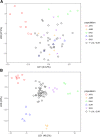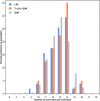Retrovirus insertion site analysis of LGL leukemia patient genomes
- PMID: 31208405
- PMCID: PMC6580525
- DOI: 10.1186/s12920-019-0549-9
Retrovirus insertion site analysis of LGL leukemia patient genomes
Abstract
Background: Large granular lymphocyte (LGL) leukemia is an uncommon cancer characterized by sustained clonal proliferation of LGL cells. Antibodies reactive to retroviruses have been documented in the serum of patients with LGL leukemia. Culture or molecular approaches have to date not been successful in identifying a retrovirus.
Methods: Because a retrovirus must integrate into the genome of an infected cell, we focused our efforts on detecting a novel retrovirus integration site in the clonally expanded LGL cells. We present a new computational tool that uses long-insert mate pair sequence data to search the genome of LGL leukemia cells for retrovirus integration sites. We also utilize recently published methods to interrogate the status of polymorphic human endogenous retrovirus type K (HERV-K) provirus in patient genomes.
Results: Our data show that there are no new retrovirus insertions in LGL genomes of LGL leukemia patients. However, our insertion call tool did detect four HERV-K provirus integration sites that are polymorphic in the human population but absent from the human reference genome, hg19. To determine if the prevalence of these or other polymorphic proviral HERV-Ks differed between LGL leukemia patients and the general population, we used a recently developed tool that reports sites in the human genome occupied by a known proviral HERV-K. We report that there are significant differences in the number of polymorphic HERV-Ks in the genomes of LGL leukemia patients of European origin compared to individuals with European ancestry in the 1000 genomes (KGP) data.
Conclusions: Our study confirms that the clonal expansion of LGL cells in LGL leukemia is not driven by the integration of a new infectious or endogenous retrovirus, although we do not rule out that these cells are responding to retroviral antigens produced in other cell types. However, our computational analyses revealed that the genomes of LGL leukemia patients carry a higher burden of polymorphic HERV-K proviruses compare to individuals from KGP of European ancestry. Our research emphasizes the merits of comprehensive genomic assessment of HERV-K in cancer samples and suggests that further analyses to determine contributions of HERV-K to LGL leukemia are warranted.
Keywords: Genomic insertion; HERV-K; Large granular lymphocyte leukemia; Retrovirus; Visualization tool.
Conflict of interest statement
The authors declare that they have no competing interests.
Figures




Similar articles
-
A computational framework to assess genome-wide distribution of polymorphic human endogenous retrovirus-K In human populations.PLoS Comput Biol. 2019 Mar 28;15(3):e1006564. doi: 10.1371/journal.pcbi.1006564. eCollection 2019 Mar. PLoS Comput Biol. 2019. PMID: 30921327 Free PMC article.
-
Evolutionary dynamics of the human endogenous retrovirus family HERV-K inferred from full-length proviral genomes.J Mol Evol. 2001 Sep;53(3):237-43. doi: 10.1007/s002390010213. J Mol Evol. 2001. PMID: 11523010
-
Genome-wide amplification of proviral sequences reveals new polymorphic HERV-K(HML-2) proviruses in humans and chimpanzees that are absent from genome assemblies.Retrovirology. 2015 Apr 28;12:35. doi: 10.1186/s12977-015-0162-8. Retrovirology. 2015. PMID: 25927962 Free PMC article.
-
Molecular biology of type A endogenous retrovirus.Kitasato Arch Exp Med. 1990 Sep;63(2-3):77-90. Kitasato Arch Exp Med. 1990. PMID: 1710682 Review.
-
HERV-K: the biologically most active human endogenous retrovirus family.J Acquir Immune Defic Syndr Hum Retrovirol. 1996;13 Suppl 1:S261-7. doi: 10.1097/00042560-199600001-00039. J Acquir Immune Defic Syndr Hum Retrovirol. 1996. PMID: 8797733 Review.
Cited by
-
Is the HERV-K HML-2 Xq21.33, an endogenous retrovirus mutated by gene conversion of chromosome X in a subset of African populations, associated with human breast cancer?Infect Agent Cancer. 2020 Mar 7;15:19. doi: 10.1186/s13027-020-00284-w. eCollection 2020. Infect Agent Cancer. 2020. PMID: 32165916 Free PMC article.
-
Lack of Viral Load Within Chronic Lymphoproliferative Disorder of Natural Killer Cells: What Is Outside the Leukemic Clone?Front Oncol. 2021 Jan 18;10:613570. doi: 10.3389/fonc.2020.613570. eCollection 2020. Front Oncol. 2021. PMID: 33585237 Free PMC article.
-
Mosaicism in Human Health and Disease.Annu Rev Genet. 2020 Nov 23;54:487-510. doi: 10.1146/annurev-genet-041720-093403. Epub 2020 Sep 11. Annu Rev Genet. 2020. PMID: 32916079 Free PMC article. Review.
-
NK-type large granular lymphocyte leukemia comes of age.Hemasphere. 2025 Jun 25;9(6):e70161. doi: 10.1002/hem3.70161. eCollection 2025 Jun. Hemasphere. 2025. PMID: 40568352 Free PMC article. Review.
-
Endogenous Retroviral Elements in Human Development and Central Nervous System Embryonal Tumors.J Pers Med. 2021 Dec 8;11(12):1332. doi: 10.3390/jpm11121332. J Pers Med. 2021. PMID: 34945804 Free PMC article. Review.
References
-
- Loughran TP. Clonal diseases of large granular lymphocytes. Blood. 1993;82:1–14. - PubMed
Publication types
MeSH terms
Grants and funding
LinkOut - more resources
Full Text Sources
Miscellaneous

